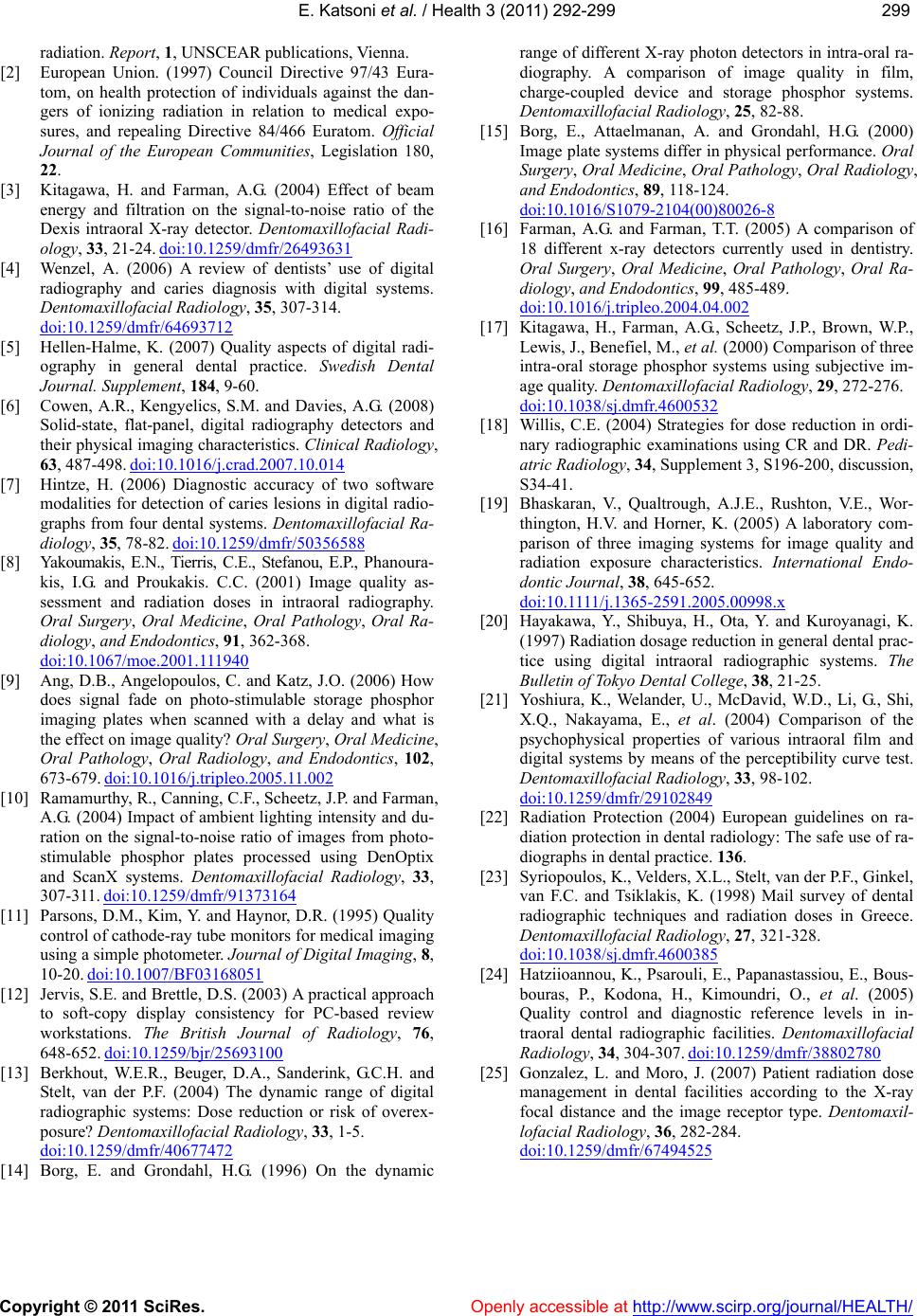
E. Katsoni et al. / Health 3 (2011) 292-299
Copyright © 2011 SciRes. http://www.scirp.org/journal/HEALTH/Openly accessible at
299299
radiation. Report, 1, UNSCEAR publications, Vienna.
[2] European Union. (1997) Council Directive 97/43 Eura-
tom, on health protection of individuals against the dan-
gers of ionizing radiation in relation to medical expo-
sures, and repealing Directive 84/466 Euratom. Official
Journal of the European Communities, Legislation 180,
22.
[3] Kitagawa, H. and Farman, A.G. (2004) Effect of beam
energy and filtration on the signal-to-noise ratio of the
Dexis intraoral X-ray detector. Dentomaxillofacial Radi-
ology, 33, 21-24. doi:10.1259/dmfr/26493631
[4] Wenzel, A. (2006) A review of dentists’ use of digital
radiography and caries diagnosis with digital systems.
Dentomaxillofacial R a d i o l o gy, 35 , 307-314.
doi:10.1259/dmfr/64693712
[5] Hellen-Halme, K. (2007) Quality aspects of digital radi-
ography in general dental practice. Swedish Dental
Journal. Supplement, 184, 9-60.
[6] Cowen, A.R., Kengyelics, S.M. and Davies, A.G. (2008)
Solid-state, flat-panel, digital radiography detectors and
their physical imaging characteristics. Clinical Radiology,
63, 487-498. doi:10.1016/j.crad.2007.10.014
[7] Hintze, H. (2006) Diagnostic accuracy of two software
modalities for detection of caries lesions in digital radio-
graphs from four dental systems. Dentomaxillofacial Ra-
diology, 35, 78-82. doi:10.1259/dmfr/50356588
[8] Yakoumakis, E.N., Tierris, C.E., Stefanou, E.P., Phanoura-
kis, I.G. and Proukakis. C.C. (2001) Image quality as-
sessment and radiation doses in intraoral radiography.
Oral Surgery, Oral Medicine, Oral Pathology, Oral Ra-
diology, and Endodontics, 91, 362-368.
doi:10.1067/moe.2001.111940
[9] Ang, D.B., Angelopoulos, C. and Katz, J.O. (2006) How
does signal fade on photo-stimulable storage phosphor
imaging plates when scanned with a delay and what is
the effect on image quality? Oral Surgery, Oral Medicine,
Oral Pathology, Oral Radiology, and Endodontics, 102,
673-679. doi:10.1016/j.tripleo.2005.11.002
[10] Ramamurthy, R., Canning, C.F., Scheetz, J.P. and Farman,
A.G. (2004) Impact of ambient lighting intensity and du-
ration on the signal-to-noise ratio of images from photo-
stimulable phosphor plates processed using DenOptix
and ScanX systems. Dentomaxillofacial Radiology, 33,
307-311. doi:10.1259/dmfr/91373164
[11] Parsons, D.M., Kim, Y. and Haynor, D.R. (1995) Quality
control of cathode-ray tube monitors for medical imaging
using a simple photometer. Journal of Digital Imaging, 8,
10-20. doi:10.1007/BF03168051
[12] Jervis, S.E. and Brettle, D.S. (2003) A practical approach
to soft-copy display consistency for PC-based review
workstations. The British Journal of Radiology, 76,
648-652. doi:10.1259/bjr/25693100
[13] Berkhout, W.E.R., Beuger, D.A., Sanderink, G.C.H. and
Stelt, van der P.F. (2004) The dynamic range of digital
radiographic systems: Dose reduction or risk of overex-
posure? Dentomaxillofacial Radiology, 33, 1-5.
doi:10.1259/dmfr/40677472
[14] Borg, E. and Grondahl, H.G. (1996) On the dynamic
range of different X-ray photon detectors in intra-oral ra-
diography. A comparison of image quality in film,
charge-coupled device and storage phosphor systems.
Dentomaxillofacial R a d i o l o gy, 25 , 82-88.
[15] Borg, E., Attaelmanan, A. and Grondahl, H.G. (2000)
Image plate systems differ in physical performance. Oral
Surgery, Oral Medicine, Oral Pathology, Oral Radiology,
and Endodontics, 89, 118-124.
doi:10.1016/S1079-2104(00)80026-8
[16] Farman, A.G. and Farman, T.T. (2005) A comparison of
18 different x-ray detectors currently used in dentistry.
Oral Surgery, Oral Medicine, Oral Pathology, Oral Ra-
diology, and Endodontics, 99, 485-489.
doi:10.1016/j.tripleo.2004.04.002
[17] Kitagawa, H., Farman, A.G., Scheetz, J.P., Brown, W.P.,
Lewis, J., Benefiel, M., et al. (2000) Comparison of three
intra-oral storage phosphor systems using subjective im-
age quality. Dentomaxillofacial Radiology, 29, 272-276.
doi:10.1038/sj.dmfr.4600532
[18] Willis, C.E. (2004) Strategies for dose reduction in ordi-
nary radiographic examinations using CR and DR. Pedi-
atric Radiology, 34, Supplement 3, S196-200, discussion,
S34-41.
[19] Bhaskaran, V., Qualtrough, A.J.E., Rushton, V.E., Wor-
thington, H.V. and Horner, K. (2005) A laboratory com-
parison of three imaging systems for image quality and
radiation exposure characteristics. International Endo-
dontic Journal, 38, 645-652.
doi:10.1111/j.1365-2591.2005.00998.x
[20] Hayakawa, Y., Shibuya, H., Ota, Y. and Kuroyanagi, K.
(1997) Radiation dosage reduction in general dental prac-
tice using digital intraoral radiographic systems. The
Bulletin of Tokyo Dental College, 38, 21-25.
[21] Yoshiura, K., Welander, U., McDavid, W.D., Li, G., Shi,
X.Q., Nakayama, E., et al. (2004) Comparison of the
psychophysical properties of various intraoral film and
digital systems by means of the perceptibility curve test.
Dentomaxillofacial R a d i o l o gy, 33 , 98-102.
doi:10.1259/dmfr/29102849
[22] Radiation Protection (2004) European guidelines on ra-
diation protection in dental radiology: The safe use of ra-
diographs in dental practice. 136.
[23] Syriopoulos, K., Velders, X.L., Stelt, van der P.F., Ginkel,
van F.C. and Tsiklakis, K. (1998) Mail survey of dental
radiographic techniques and radiation doses in Greece.
Dentomaxillofacial R a d i o l o gy, 27 , 321-328.
doi:10.1038/sj.dmfr.4600385
[24] Hatziioannou, K., Psarouli, E., Papanastassiou, E., Bous-
bouras, P., Kodona, H., Kimoundri, O., et al. (2005)
Quality control and diagnostic reference levels in in-
traoral dental radiographic facilities. Dentomaxillofacial
Radiology, 34, 304-307. doi:10.1259/dmfr/38802780
[25] Gonzalez, L. and Moro, J. (2007) Patient radiation dose
management in dental facilities according to the X-ray
focal distance and the image receptor type. Dentomaxil-
lofacial Radiology, 36, 282-284.
doi:10.1259/dmfr/67494525